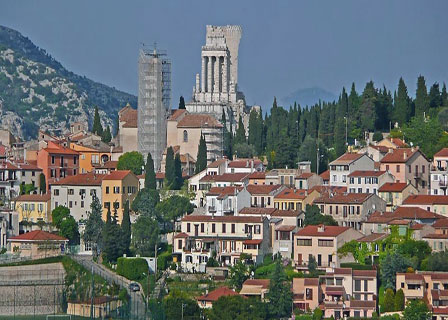The American Riviera
La Turbie

La Turbie, 600 meters above the stacked concrete of Monaco, is a medieval village with many arched passageways and steep staircases. The village’s proudest possession is the ruin of a great monument dedicated to Octavian, the future Emperor Augustus. This is the Trophée des Alpes, built by the Romans in the 6th century BC and constructed to celebrate Octavian’s vanquishing of the wild Ligurian mountain tribes who populated the Alpes Maritimes at that time, constantly threatening the Roman trade routes. The monument once sheltered a statue of Octavian, but vandalism over the centuries culminated with the building of a fortress during the war between Savoy and France, which ensured its almost complete ruin when in 1705, King Louis XIV of France ordered its partial destruction, fearing it could become a fortification used by the enemy. The Trophy was then ravaged by the local people and the stones used to build houses and the nearby church of Saint-Michel. So it remained until 1929 when an American, Edward Tuck, financed the restauration of the monument. Born in New Hampshire, Tuck, a Francophile, had been Vice Consul at the American Consulate in Paris. He was also a banker and philanthropist who founded the Tuck School of Business, also in New Hampshire. In 1889 he became an expatriate in France, and here he redesigned, as his home, the elegant Domaine de Vert-Mont outside Paris. This is now the Fondation Tuck. He died, a widow, in Monte Carlo in 1938.

La Turbie has another, less salubrious, fortification. The Fort de la Revère is a dreary old garrison in a forested area above the village, built around 1883 and designed to cover enemy action from the east. Abandoned after the First World War it found a new use in 1940 when the Vichy government opened it as an internment camp for Allied prisoners of war, initially RAF pilots and later soldiers and sailors. The internees were allowed out in guarded groups to shop in Nice, and the Red Cross permitted to deliver much needed articles such as British military outfits, shirts and underclothes. Food parcels were the most welcome of all. But, as instructed by Winston Churchill, the prisoners made repeated attempts to escape, on one occasion sliding down a sewage shute onto the hillside. The aim of all the prisoners was to reach Marseilles and the escape lines which were being organised from that rough melting pot of a town. Many made their way via Monte Carlo where they were sheltered in an empty apartment owned by two elderly sisters, Eva and Susie Trenchard, who ran the Scottish Tea Shop in the town. After the war these brave women would be awarded a King’s Commendation for bravery.
From Riviera Dreaming – Love and War on the Côte dAzur. © 2020 Maureen Emerson
